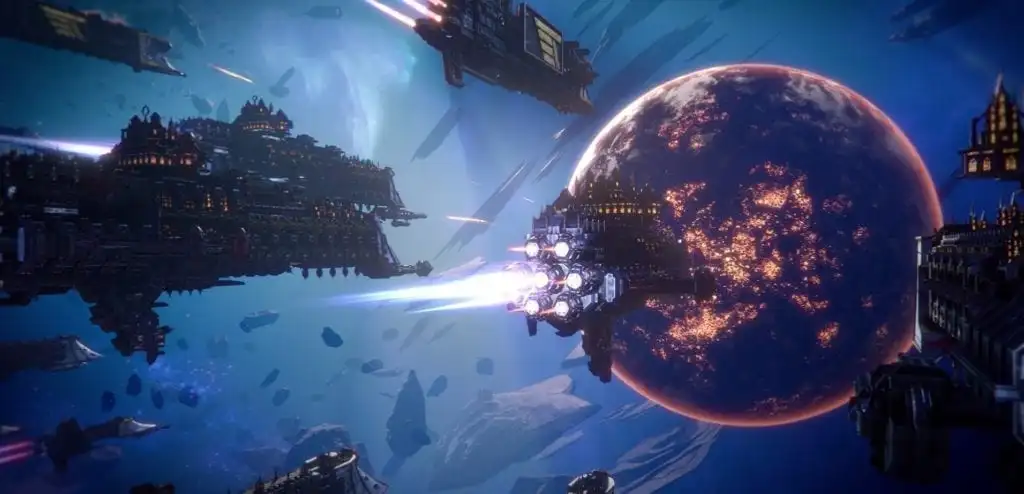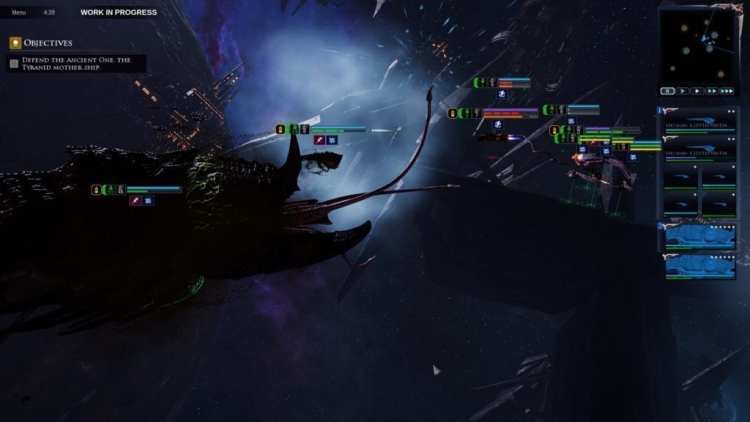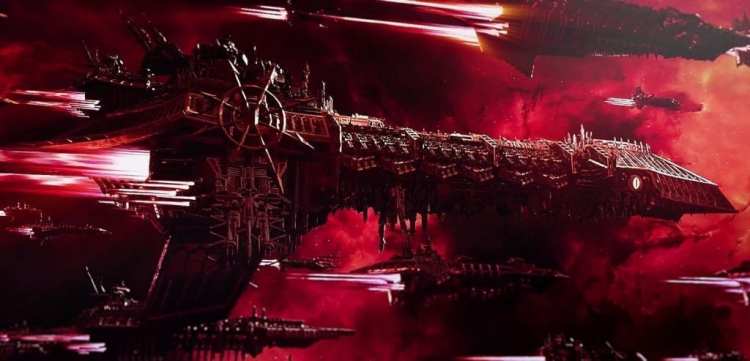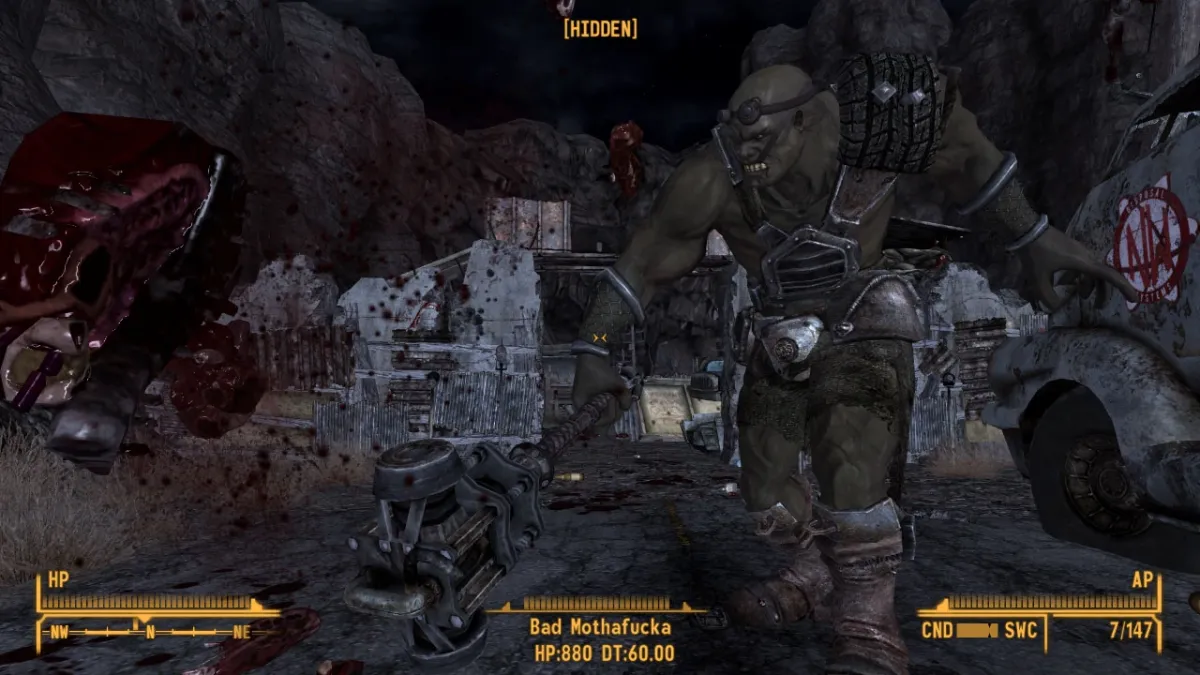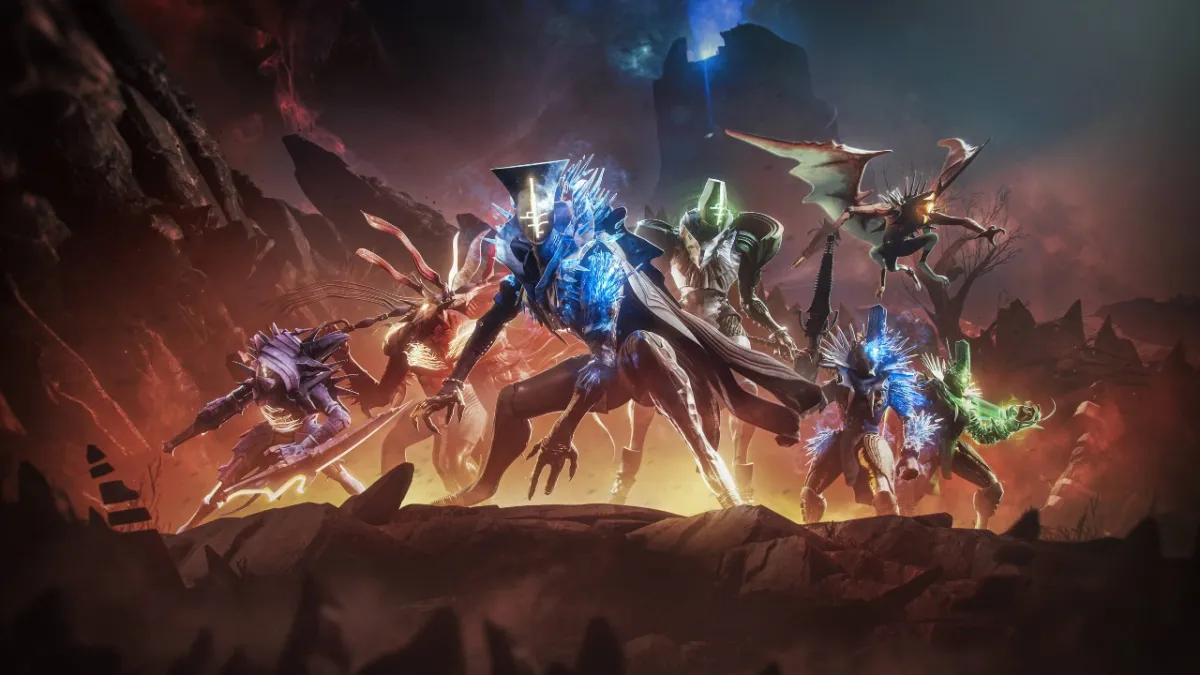In space, no one can hear you scream. Those screams, however, can be a sign of jubilation or just sheer frustration. Battlefleet Gothic: Armada 2 provides plenty of opportunities for both. It is the sequel to Tindalos Interactive’s pausable real-time naval warfare strategy game in space (that’s a mouthful even Tyranids would have a hard time chewing on). It’s also based on a Games Workshop board game that’s an off-shoot of Warhammer 40,000 or Warhammer 40K. Battlefleet Gothic: Armada 2 is ambitious, massive, and a treat for long-time Warhammer 40K fans. Sadly, it also has some glaring flaws.
Full Disclosure: We were provided with two review codes. One for the game itself which had its public beta 2 playable by those who pre-ordered. The other is for the press/review version. The game/beta 2 only has the prologue and starting sectors for a couple of campaigns, although it does have multiplayer. The press version has all three campaigns playable past the initial sector, minus the multiplayer. Both were works-in-progress as of this writing. There were a number of issues, including unavoidable crashes, which I’ll detail below.
Fixes are incoming in time for launch, which is good to hear. As such, we’ll only be able to provide a final score once I’m done checking out what has been fixed. Still, that doesn’t detract from the fact that the core mechanics of Battlefleet Gothic: Armada 2 are already in place.
Update: The game has officially launched and with it comes a number of fixes. You can check out the patch notes here.
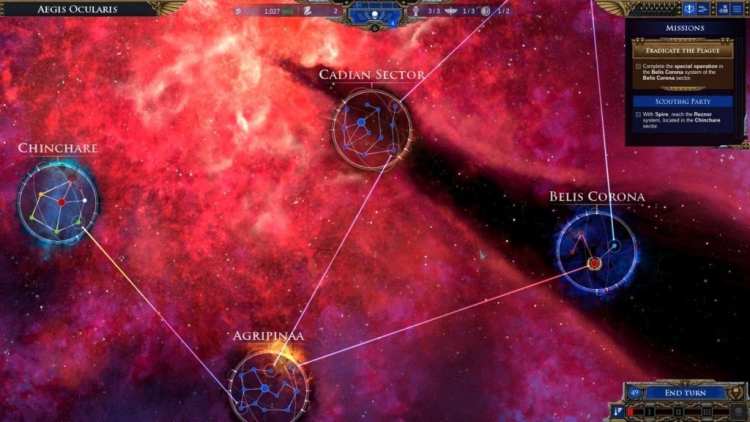
The sectors in the Aegis Ocularis, each with a number of systems that you’ll need to attack, control, and defend.
Cadia Stands… Or Not
Battlefleet Gothic: Armada 2 is the first Warhammer 40K video game set during the most recent events in the lore. Taking place during the 13th Black Crusade, the game opens with the defense of the fortress world of Cadia. The Imperium of Man, long beset by countless Xenos lifeforms and Chaos encroachments will now taste utter defeat at the hands of Abaddon the Despoiler.
Make no mistake, the prologue already gives you an idea of what the story is about. As a long-time Warhammer 40K reader, I clapped my hands and audibly gasped after seeing characters such as Trazyn the Infinite, Yvraine, and Ursarkar E. Creed (CREEEEEEEEEEEEEEEEED!) grace my screen in a video game for the first time. Numerous cameos and mission dialogue also add more flavor to the universe.
Fans may appreciate Tindalos’ efforts in using the source material, but newcomers need not worry about getting lost. The game has a number of cutscenes detailing each faction that you meet and even each system that you visit. Do note, however, that almost all cinematics (minus the intros) play out the same way. It would’ve been a sight to see sector and faction intros from another perspective.
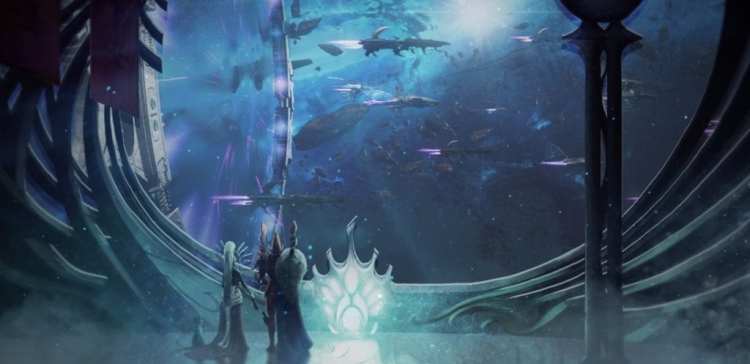
New systems you explore and factions you encounter have their own intros. This one is for the Aeldari (or Eldar).
For The Emprah!
Battlefleet Gothic: Armada 2 provides you with three campaigns — the Imperium, the Necrons, and the Tyranids. For the Imperium, you play as Admiral Spire, the hero of the Gothic War and the main protagonist from the first game. His survival is made apparent early on, having been stuck in the Warp with 800 years passing in real-time.
As Spire, you’ll have to call on scattered forces to make a desperate stand against the coming tide. You’ll have access to ships from the Imperial Navy, Adeptus Mechanicus, and Space Marines. Each sub-faction has notable traits and skills to make them slightly different from one another. For instance, AdMech are easily susceptible to boarding (they’re frail half-robots, after all) and they don’t have battlecruisers or grand cruisers. However, owing to technological advancements, many of their ships have access to nova cannons.
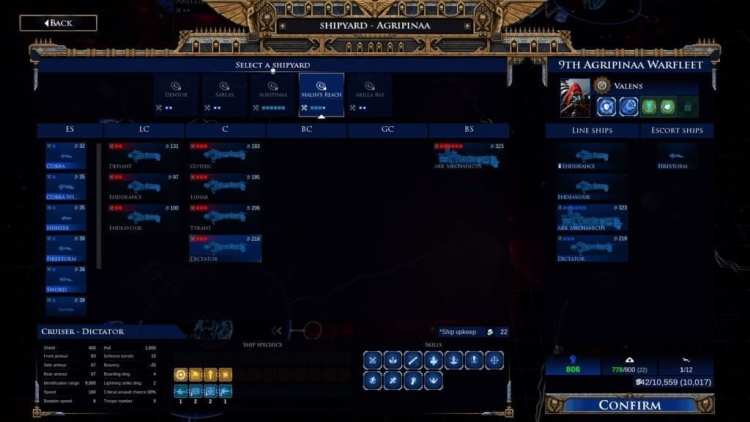
Me: “Initiate data transfer. Adeptus Mechanicus forges. Ship design = 100%.” Everyone else: “No, you’re not doing that thing you did with the 40K Mechanicus review.”
The Necrons, meanwhile, operate differently. Their ships focus on long-range fire, teleportation, and summoning. As for the Tyranids, the campaign is a lot more unique in that it’s told from the perspective of races and would-be victims that encounter them.
You’ll move from one system to another, taking out opposing fleets, leveling up planets, creating new ships, or building defenses. Certain planets have specific traits that give you extra resources, ship construction points, troop replenishment, and battle plans to unlock more systems. There are also those that hinder you such as resource drains, slower planetary evolution, and even those that have a chance of getting randomly invaded by pirates or Xenos.
In the case of the Tyranids, it’s like a race with a lot of spurts. You end up devouring each system you capture, and there are those that provide massive resources in the form of biomass. Once a system is devoured, no more biomass and you’ll have to move on. You can also set up vanguard forces to disrupt troops, allow instant fleet teleportation, and even summon an infested space hulk.
All Systems Active for Battlefleet Gothic Armada 2
Battles and missions award renown for leveling up. Doing so increases your fleet cap, allows you to build better ships, and lets you choose a new perk.
Battles take place in an isometric plane with a background of the area you’re fighting in. Some are fairly unique (ie. Cadia), while others tend to be more generic with some ominous or “grimdark” details in the background. These backgrounds and the ships themselves are quite striking.
You can have your ships engage targets manually or automatically. The latter lets you determine the angle and distance at which your ships engage. Note that you can also prioritize enemy ships and which parts to focus your fire on (ie. decks, engines, weapons, or bridge). When certain parts of ships are destroyed, abilities are lost. These range from nova cannons, teleportation, scarab swarms, fighter and bomber squadrons, tight maneuvers/stances, boarding torpedoes, and more. Unlike the first game where you need to assign specific upgrades to ships, this time around the ships themselves come with their own weapon systems and abilities, whereas additional skills are tied to your captains. The mechanics are a step up from the original.

Necrons: Inertialess Drive teleport + Starpulse Wave explosions + Lightning Link = kill everything that flies towards you in a straight line. You could also opt for Scarab Swarms and Transdimensional Thunderbolts.
While a majority of the game’s battles are random skirmishes with other forces (which you can auto-resolve with random results each time), you’ll also have dozens of scripted missions. These add more detail to the game world. Some task you with boarding an Eldar vessel to forge an alliance with Yvraine (complete with a trippy dream-like state). Others will have you take on Abaddon’s lieutenants, each with their own “specialty” (such as a plague ship or corrupted Slaaneshi rock formations that stun your craft). Many of these also introduce new random events that can happen in future battles like insta-kill meteor showers and solar flares that deplete shields. Of course, some are also quite preposterous, such as Trazyn blowing up the Phalanx (the Sons of Lord Adorable wept).
For the most part, space battles are just about what you can expect — chaotic, confusing, and yes, fun! Zooming in lets you see more details from fighter squadrons duking it out, boarding torpedoes homing in, and bulkheads collapsing. Fires erupt, macro weapons and lasers light up the void, and otherwordly creatures move with alarming distinction.
Ramming several Chaos and Eldar vessels with your Space Marine Battle Barge Mk. II or Necron Cairn resulting in multiple explosions never gets old! What does get old is getting there in the first place.

Lord Adorable’s Phalanx destroys the Will of Eternity Blackstone Fortress. “Despoiler” Alert: It’s not a happy ending.
Oh, Captain, We’re Cappin’
While the campaign maps give you an idea of how vast the Aegis Ocularis is, it also means playing a game of whack-a-mole (or whack-a-Xenos). You can lower their XCOM-esque “threat level” or slow down their advance by stationing fleets, adding minefields, or completing missions, but they’ll still keep coming. That means you’ll spend a lot of time planning your next moves and ensuring that your forces aren’t stretched to the breaking point.
Those are but minor concerns. The main problem with Battlefleet Gothic: Armada 2 is with its battle system. Ship maneuverability and pathing can be annoying. I can’t count the number of times that my ships ended up bumping into each other, idling, or flying out into the open and getting peppered with lance cannons just because I ordered them to “turn slightly to the left.” That might be a reason why large-scale space battles aren’t part of the game (reinforcements would, instead, trickle in). If they were then it’d take just a few pathing issues for every vessel to turn into a drifting hulk.
Another downside is that you can’t merge or attach ships to other fleets, or put them in your reserves. For all intents and purposes, they’re stuck with the fleet that they started out with unless you scrap them.
Scripted missions are a breath of fresh air because regular battles become easily predictable. Due to adding a “Domination” game mode by default — aka. capturing points on maps — the enemy AI will just fly straight to the closest victory point. This means you can predict where they’ll go and launch your torpedoes, squadrons, Necron thunderbolts, and Tyranid acid blobs before they get there. You’re just moving from one battle to another doing the same tactics as before. I can understand the need for this change. The first Battlefleet Gothic game had players running stealthed and hiding in map corners. Adding capture points means a new dynamic to PvP battles, although it has an adverse effect of making the AI incompetent.

Imperium: Wait for enemy ships to cap a point. Fire all Nova Cannons and drop Plasma Mines. Check out that victory screen a few seconds later.
The Game Broke Before The Guard Did
Given that Battlefleet Gothic: Armada 2 is based on a tabletop game, there are going to be lots of players clamoring for competition. Sadly, multiplayer can be uneven. Because of the game’s mechanics, you’re just waiting for your opponent to make one misstep while using skills that travel from one corner of the map to another. All the while, you’ll just have escorts skirting on the edges to cap points. Of the ten games I played (of which I won seven), either I demolished my opponent before they even reached me or I had my Tyranid fleet gobble them up.
With crew numbers (aka. your ship’s population) added in the game, it also creates a lot of imbalance. The current meta involves a lot of boarding actions and lightning strikes. Tyranids will “om nom nom” everyone and Orks will just ram you to oblivion. Multiplayer has twelve factions each with their own sub-factions and selectable skills so it’s a damn shame that PvP combat turns into a mundane experience. Why bother with tactical acumen and utility skills when the easiest path to victory is just killing off a limited number of troops when your boarding skills are off-cooldown?
Perhaps the biggest reason I cannot provide an actual score just yet is that many of these issues have yet to be fixed. That includes the “unavoidable crash” I mentioned earlier. During the midgame, a random Chaos fleet invades the Scelus system. You might as well call it Thanos. Dread it, run from it, this fleet will crash your game. We’ve been told that fixes are incoming once the game launches which is why I’ll definitely check it again.
Live At Launch Day (Battlefleet Gothic Armada 2 review update)
Tindalos Interactive tried to ensure that Battlefleet Gothic: Armada 2 is in prime condition on launch day. The recent patch notes reflect a number of improvements across the board from enemy AI corrections and fixing localized crashes, to including “Cruiser Clash” mode which removes the capture points in battle maps. For those looking to enjoy the game at a leisurely pace, you’ll also be able to remove the Threat Level whenever you start a new campaign. Multiplayer also had some balancing tweaks and you can now rank up your faction’s level from your skirmish matches against the AI.
The launch day patch also fixed the crashes I was experiencing for the review copy, allowing me to continue and finish my Necron campaign after roughly 15 hours of play. And boy, oh boy, what a doozy it was! From the midgame onwards, the challenge ramps up considerably owing to numerous fleets invading your systems. You might not even be able to save them all.
Thankfully, there were also Annihilation Missions that capped off questlines to eliminate certain factions. You can see the video below for the Annihilation Mission to take out the Orks. I was already halfway through this mission and I sped it up for the most part since I was spamming Transdimensional Thunderbolt.
Despoiler Alert
A few issues still exist here and there even after the launch day patch. Your fleet capacity is still somewhat limited, but the enemy AI brings entire armadas to create that epic feel. Boarding actions are still the meta and multiplayer would require a few extra tweaks. Pathing still remains a problem though slightly mitigated by some extra micromanagement, and I’ve adapted to this issue after hours of play.
Still, these didn’t detract from what is, overall, an exciting foray into the current setting of Warhammer 40K’s lore. The visuals and effects are eye-catching, and factions offer unique variations in gameplay. The audio is crisp with ear-splitting vessel explosions and space whale shrieks. Switching from “Domination” to “Cruiser Clash” also made regular battles more free-flowing. From there, it’s smooth sailing from one mission to the next. Who knows, you might even encounter a certain “rowboat” fella later on.
It goes without saying that Battlefleet Gothic: Armada 2 captured the essence of the Warhammer 40K universe. With a number of planned post-launch content — new ships, the removal of the fleet cap in multiplayer, a polished campaign co-op mode, more tweaks, and even a fourth grand campaign — Battlefleet Gothic: Armada 2 is a game that strategy fans should watch out for. It’s something that Trazyn the Infinite might end up getting for his collection.

